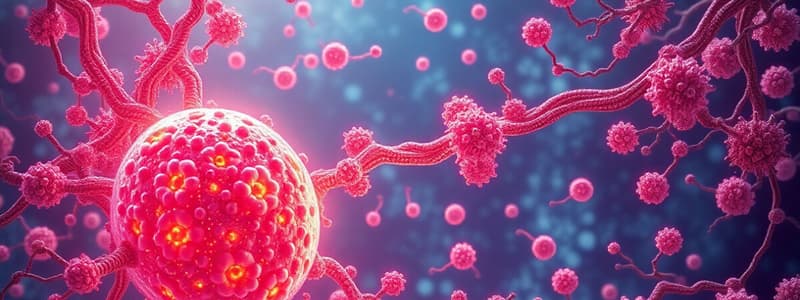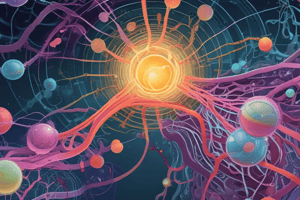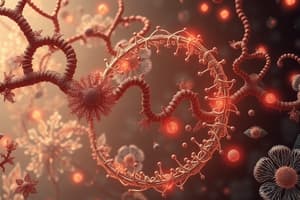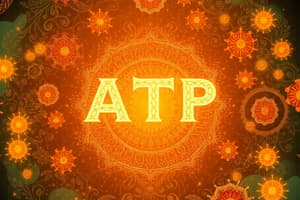Podcast
Questions and Answers
What type of reactions are characterized by complex molecules being broken down into simpler compounds?
What type of reactions are characterized by complex molecules being broken down into simpler compounds?
- Exergonic reactions
- Catabolic reactions (correct)
- Endergonic reactions
- Anabolic reactions
Endergonic reactions release energy.
Endergonic reactions release energy.
False (B)
What is the process called when ATP transfers a phosphate group to a reactant?
What is the process called when ATP transfers a phosphate group to a reactant?
Phosphorylation
The amount of energy that is __________ or __________ is equal to the difference between the potential energy of the reactants and __________.
The amount of energy that is __________ or __________ is equal to the difference between the potential energy of the reactants and __________.
Match the types of reactions with their characteristics:
Match the types of reactions with their characteristics:
Which of the following statements about ATP is true?
Which of the following statements about ATP is true?
Enzymes are consumed in the reactions they catalyze.
Enzymes are consumed in the reactions they catalyze.
What is the role of enzymes in cellular reactions?
What is the role of enzymes in cellular reactions?
Which of the following is a key difference between omega-3 and omega-6 fatty acids?
Which of the following is a key difference between omega-3 and omega-6 fatty acids?
Water-soluble vitamins are stored in the body's fat tissue.
Water-soluble vitamins are stored in the body's fat tissue.
What is the primary purpose of cellular respiration?
What is the primary purpose of cellular respiration?
Animals eat to gain organic molecules, essential nutrients, and fuel for ____________.
Animals eat to gain organic molecules, essential nutrients, and fuel for ____________.
Match the following vitamins and minerals with their function:
Match the following vitamins and minerals with their function:
Elimination is the removal of _____________________________ materials out of the digestive tract.
Elimination is the removal of _____________________________ materials out of the digestive tract.
Which of the following is an example of a bulk feeder?
Which of the following is an example of a bulk feeder?
All animals possess an alimentary canal.
All animals possess an alimentary canal.
What is one example of a fluid feeder?
What is one example of a fluid feeder?
Match the following feeding mechanisms with their examples:
Match the following feeding mechanisms with their examples:
Which structure in birds is specifically adapted to support flight?
Which structure in birds is specifically adapted to support flight?
Anatomy is the study of how body structures function.
Anatomy is the study of how body structures function.
What is the observable traits of an organism referred to as?
What is the observable traits of an organism referred to as?
Nerve impulses cause ________________________; hormones usually ________________________.
Nerve impulses cause ________________________; hormones usually ________________________.
Which component of a feedback loop detects changes in the environment?
Which component of a feedback loop detects changes in the environment?
Humans undergo _____ mitotic divisions from zygote to newborn.
Humans undergo _____ mitotic divisions from zygote to newborn.
The structure of an animal’s forelimbs modified as wings reflects its _____ for flight.
The structure of an animal’s forelimbs modified as wings reflects its _____ for flight.
List five examples of things that are regulated in our bodies.
List five examples of things that are regulated in our bodies.
Negative feedback mechanisms enhance the initial stimulus to maintain homeostasis.
Negative feedback mechanisms enhance the initial stimulus to maintain homeostasis.
Natural selection acts upon which of the following?
Natural selection acts upon which of the following?
Match the levels of organization found in an individual human with their definitions:
Match the levels of organization found in an individual human with their definitions:
What happens if the blood glucose regulatory mechanisms fail due to too much insulin?
What happens if the blood glucose regulatory mechanisms fail due to too much insulin?
Describe the relationship between structure and function in biology.
Describe the relationship between structure and function in biology.
Glucagon increases blood glucose by stimulating cells to release glucose into the blood ∴ ___________________________ blood glucose.
Glucagon increases blood glucose by stimulating cells to release glucose into the blood ∴ ___________________________ blood glucose.
Match the pancreatic hormone with its action:
Match the pancreatic hormone with its action:
What would a positive feedback loop look like in the body?
What would a positive feedback loop look like in the body?
Flashcards are hidden until you start studying
Study Notes
Cellular Metabolism
- Cellular metabolism refers to all chemical reactions occuring in a cell
- Catabolic reactions break down complex molecules into simpler molecules, releasing energy.
- Anabolic reactions build complex molecules from simpler ones, requiring energy.
- Photosynthesis is an anabolic reaction
- Anabolic and catabolic reactions are coupled by ATP.
ATP
- ATP hydrolysis releases potential energy.
- ATP is hydrolyzed to ADP + Pi + free energy.
- The energy released from ATP hydrolysis is used by anabolic reactions to build organic molecules.
- Catabolic reactions release energy which is stored as ATP.
- ATP powers anabolic reactions.
- This is energy coupling: energy from exergonic reactions fuels endergonic reactions.
- ATP is a renewable resource.
Phosphorylation
- ATP hydrolysis transfers a phosphate group to a reactant, which is called phosphorylation.
- Phosphorylation makes reactants more reactive by increasing their free energy.
- This energy is used to drive chemical, transport and mechanical work.
Cellular Reactions: Enzymes
- Enzymes are proteins that act as catalysts.
- Catalysts speed up the rate of a reaction without being consumed in the process.
- Enzymes are reusable.
- Enzymes are critical for life's reactions, as they speed up processes that would otherwise be too slow.
Human Development
- Humans are animals, and begin as zygotes.
- Between the zygote and newborn stages, human cells undergo 41 mitotic divisions.
- This results in 241 (more than 2 trillion) cells.
- Human cells differentiate, resulting in a newborn with over 2 trillion cells that form tissues, organs and organ systems.
Anatomy and Physiology
- Anatomy is the study of structures and their relationships.
- Physiology is the study of how body structures function.
Animal Structure
- Animal structure has a hierarchy.
- There is a close relationship between structure and function.
Adaptions for Flight
- Forelimbs are modified as wings with light-weight keratin feathers.
- Strong pectoral muscles are anchored to a keel (sternum).
- Reduction in mass of some organs.
- Lungs with air sacs.
- Four-chambered heart.
- Extended vision and coordination.
Phenotype
- Phenotype is observable traits.
- An organism's phenotype reflects the relationship between genotype and environment.
- Natural selection only acts on phenotype.
Nervous and Endocrine system
- Nerve impulses cause rapid, short-term responses.
- Hormones usually cause slower but longer-lasting responses.
Feedback Loops
- Feedback loops help maintain homeostasis.
- A system needs a sensor to detect changes, a control center to coordinate a response, and an effector to exert a response.
Negative Feedback
- Negative feedback opposes the initial stimulus.
- This brings internal conditions back to a tolerable range.
- The control center determines the set point, compares input with the normal range, and activates the effector if needed.
Blood Glucose Regulation
- Blood glucose levels are tightly regulated by two pancreatic hormones.
- Glucagon increases blood glucose by stimulating cells to release glucose into the blood, thus raising blood glucose.
- Insulin stimulates cells to take glucose out of the blood and store it, thus lowering blood glucose.
Digestive System
- Animals eat for organic molecules, essential nutrients and fuel for cellular respiration.
- Organic molecules are needed to synthesize new molecules.
- Essential nutrients are those the organism cannot make on its own (e.g, essential vitamins and minerals).
Cellular Respiration
- Cellular respiration is the process of breaking down glucose to produce ATP.
- This process has three stages: glycolysis, citric acid cycle and electron transport chain (not stated in the text).
- Glycolysis occurs in the cytoplasm of all cells.
- The citric acid cycle occurs in the cytoplasm of prokaryotes and the matrix of mitochondria in eukaryotes.
- Electron transport chain occurs in the inner membrane of mitochondria (not stated in the text).
Digestive Compartments
- Most animals have a specialized digestive tract.
- Food is digested in organ compartments that house hydrolytic enzymes.
- Some animals have a sac with a single opening called a gastrovascular cavity (e.g., hydra).
Alimentary Canal
- Most animals have an alimentary canal.
- Alimentary canal is a tube that runs between two openings.
- The alimentary canal is divided into compartments that process food sequentially.
- These compartments include: pharynx, esophagus, crop, stomach, gizzard, intestine, and anus.
- The crop stores food pre-digestion.
- The gizzard grinds food.
Studying That Suits You
Use AI to generate personalized quizzes and flashcards to suit your learning preferences.




